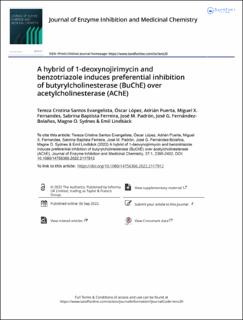A hybrid of 1-deoxynojirimycin and benzotriazole induces preferential inhibition of butyrylcholinesterase (BuChE) over acetylcholinesterase (AChE)
Evangelista, Tereza Cristina Santos; Lopez, Oscar; Puerta, Adrian; Fernandes, Miguel X.; Ferreira, Sabrina Baptista; Padron, Jose M.; Fernandez-Bolanos, Jose G.; Sydnes, Magne Olav; Lindback, Emil
Peer reviewed, Journal article
Published version
Permanent lenke
https://hdl.handle.net/11250/3059711Utgivelsesdato
2022Metadata
Vis full innførselSamlinger
Originalversjon
Evangelista, T. C. S., López, Ó., Puerta, A., Fernandes, M. X., Ferreira, S. B., Padrón, J. M., ... & Lindbäck, E. (2022). A hybrid of 1-deoxynojirimycin and benzotriazole induces preferential inhibition of butyrylcholinesterase (BuChE) over acetylcholinesterase (AChE). Journal of Enzyme Inhibition and Medicinal Chemistry, 37(1), 2395-2402. 10.1080/14756366.2022.2117912Sammendrag
The synthesis of four heterodimers in which the copper(I)-catalysed azide-alkyne cycloaddition was employed to connect a 1-deoxynojirimycin moiety with a benzotriazole scaffold is reported. The heterodimers were investigated as inhibitors against acetylcholinesterase (AChE) and butyrylcholinesterase (BuChE). The heterodimers displayed preferential inhibition (> 9) of BuChE over AChE in the micromolar concentration range (IC50 = 7–50 µM). For the most potent inhibitor of BuChE, Cornish-Bowden plots were used, which demonstrated that it behaves as a mixed inhibitor. Modelling studies of the same inhibitor demonstrated that the benzotriazole and 1-deoxynojirimycin moiety is accommodated in the peripheral anionic site and catalytic anionic site, respectively, of AChE. The binding mode to BuChE was different as the benzotriazole moiety is accommodated in the catalytic anionic site.

